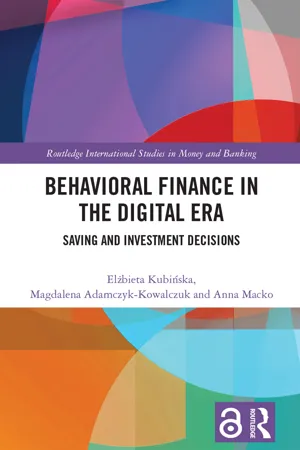Economics
Saving and Investing
Saving involves setting aside a portion of income for future use, typically in low-risk, easily accessible accounts. Investing, on the other hand, involves using money to acquire assets with the expectation of generating income or profit. While saving is generally considered low-risk, investing carries higher risk but also the potential for higher returns. Both are important for building wealth and financial security.
Written by Perlego with AI-assistance
Related key terms
Related key terms
1 of 4
Related key terms
1 of 3
7 Key excerpts on "Saving and Investing"
- eBook - ePub
Economics
The Definitive Encyclopedia from Theory to Practice [4 volumes]
- David A. Dieterle, David A. Dieterle, David A. Dieterle(Authors)
- 2017(Publication Date)
- Greenwood(Publisher)
S SAVING VERSUS INVESTINGFor centuries Saving and Investing money have offered different approaches to achieving financial security, but it was not until the late 19th and early 20th century that saving money in banks became widespread in many developed societies.Saving in the financial sense means depositing funds in an institution under terms that leave funds available upon request without fear of financial fluctuations impacting the amount at hand. In exchange for allowing the institutions, usually banks, to be custodian of the funds, the institutions promise and pay a regular interest rate of return on the funds deposited, allowing the depositor’s assets to grow over time.Traditional savings vehicles include savings accounts, checking accounts, and certificates of deposit (CDs). CDs involve investing for specified periods, after which the funds can be accessed. They traditionally pay a higher rate of interest than savings and checking accounts. The combination of a guaranteed interest rate and ready access to one’s money affords a sense of security and peace of mind. Technically, depositing funds in an institution for savings purposes is investing in that institution, yet one does so with some expectation of moderate growth via interest rate earnings.Savings funds afford security and ready access to funds. If one’s goal is to use the funds for a major purchase in the near future, it’s prudent to deposit the money at hand in a savings account. In the event of unexpected events that require funds, such as repairs to property not covered by insurance, medical expenses, and other such emergencies, funds saved in commercial institutions with retail offices can be readily accessed for use.In practice, investing involves a more speculative approach and more risk than a guaranteed interest rate. Investing means committing funds to a pursuit with the expectation that a profit will be earned by the project’s efforts, increasing the wealth of the investor. Individuals and institutions can and do invest widely, from commercial companies to real estate undertakings to intellectual proposals that evolve into inventions. Investing in a company is commonly done by receiving shares of stock in the firm in return for one’s money. - Henry Hazlitt(Author)
- 2016(Publication Date)
- Golden Springs Publishing(Publisher)
“Saving is the act of the individual consumer and consists in the negative act of refraining from spending the whole of his current income on consumption.“This “saving” relates to units of money and is the sum of the differences between the money-incomes of individuals and their money-expenditure in current consumption; and “investment” relates to units of goods. The object of this chapter is to illustrate further the significance of the distinction between these two things.“Investment, on the other hand, is the act of the entrepreneur whose function it is to make the decisions which determine the amount of the non-available output, and consists in the positive act of starting or maintaining some process of production or of withholding liquid goods. It is measured by the net addition to wealth whether in the form of fixed capital, working capital or liquid capital (I, 172).”It is significant that though Keynes here defines “saving” explicitly in terms of “units of money” and “investment” explicitly in terms of “units of goods,” he then surreptitiously (or absentmindedly) introduces the element of money in “investment” under the term “liquid capital.”Small wonder that he himself later found the whole thing “very confusing!” It may be pointed out here that in the General Theory Keynes constantly uses a word like “income” without specifying or distinguishing between real income and money income. This leads to constant confusion. And as we shall see, when we do distinguish constantly and clearly between real income and money income, such plausibility as the Keynesian theories may have begins to wear off. His “system” needs this ambiguity and confusion.3. Saving as the Villain
It will be noticed, also, that in the very terms of his definitions in the Treatise on Money , Keynes manages to disparage saving while commending investment. The truth is that saving has always been the villain in the Keynesian melodrama. As far back as The Economic Consequences of the Peace- eBook - ePub
Financial Literacy and Money Script
A Caribbean Perspective
- Christine Sahadeo(Author)
- 2018(Publication Date)
- Palgrave Macmillan(Publisher)
© The Author(s) 2018 Christine Sahadeo Financial Literacy and Money Script https://doi.org/10.1007/978-3-319-77075-8_3Begin Abstract3. Saving and Investing
Christine Sahadeo1(1) St. Augustine Campus, University of the West Indies, St. Augustine, Trinidad and TobagoKeywords
Income Savings Expenses Investment Instruments Financial institutions LiterateBe financially independent, build wealth—master the art of Saving and Investing, and watch your money work for you.End AbstractThe Importance of Saving: Savings Is a Habit, Savings is a Commitment
Some mathematicians may say that the following equations are the same owing to the commutative property of equations, that is:- 1. Income − Savings = Expenses
- 2. Income – Expenses = Savings
However the consequences arising from these two equations can be very different. The rationale for the first equation is that savings should be a decision based on a goal and savings is put aside first and the residual used to pay expenses . In the second equation savings is the residual, if any, after paying expenses . Savings is income not spent or deferred consumption. It involves putting aside money from current income on a regular basis for a specific purpose or goal. Some methods of saving include old-fashioned systems such as using a piggy bank and participating in a sou-sou, saving through a financial institution via joint accounts, a range of savingsaccounts , and saving by investing in a pension plan. Financial institutions include banks, trust companies, credit unions, and other investment companies. The selection of a financial institution for investment depends on a number of factors including rate of return, charges, location, level of customer service, and types ofaccounts - eBook - ePub
Behavioral Finance in the Digital Era
Saving and Investment Decisions
- Elżbieta Kubińska, Magdalena Adamczyk-Kowalczuk, Anna Macko(Authors)
- 2023(Publication Date)
- Routledge(Publisher)
Behavioral models of financial markets are an attempt to show how the irrationality of market participants affects the equilibrium market state. First is the behavioral plan Save More Tomorrow (SMarT), developed by Thaler and Benartzi. The next model was proposed by Dacey and Zielonka, which provides insights on how to overcome the disposition effect and make more rational investment choices. This is followed by Lopes’ security-potential/aspiration theory, which offers valuable insights into how individuals perceive and evaluate investment risks and rewards. Behavioral portfolio theory, developed by Shefrin and Statman, is also discussed as it provides a framework for understanding how behavioral biases and emotions can impact portfolio construction and management. The adaptive markets hypothesis, proposed by Lo, is a market model that integrates behavioral insights. It acknowledges the role of human behavior, including cognitive biases and emotions, in shaping market dynamics. This hypothesis recognizes that market participants adapt their strategies based on their experiences and the changing environment. By incorporating behavioral aspects into the model, the adaptive markets hypothesis provides a comprehensive framework for understanding and predicting market behavior.2.1 Rational investment and savings
Keynes’ classical definition states that saving means the excess of income over expenditure on consumption (1936 , p. 56). Savings are the money that remains after deducting consumer spending from disposable income over a given period of time and therefore represent the net surplus of a person’s or household’s funds after all expenses and liabilities have been paid. Adopting Keynes’ perspective, the value of income is the combination of consumption and investment, allows for the conclusion that savings, defined as income minus consumption, are essentially equivalent to investment. In other words, the amount saved by individuals is channeled into investment activities. Savings and investments play a crucial role in both individual financial well-being and the overall functioning of the economy. When individuals save and invest, they not only secure their own financial future but also contribute to the availability of investment capital in the broader economic context. In the traditional economic model, savings and investments by private individuals serve as a vital source of investment capital. On a macroeconomic scale, household savings stimulate economic growth by facilitating bank lending to businesses and by directly or indirectly financing investments in enterprises.Keynes (ibid.) identified 8 motives for why people save, providing a comprehensive range of saving motives that drive decisions to save. Keynes also referred to homo economicus, the rational man, by outlining the motivational background to the simple decision to abstain from consumption and deciding to save. Savings provide a sense of security, and people with savings are better able to deal with and overcome economic crises. Thanks to the precautionary motive (motive 1: to build up a reserve against unforeseen contingencies), savings as an asset earmarked for the future provide security to cover unexpected expenses, freeing us from having to rely on credit. They are a tool to manage our wealth over time, as part of the life-cycle motive (motive 2: to provide for an anticipated future relationship between the income and the needs of the individual), and they take into account the time value of money (motive 3: to enjoy interest and appreciation). Savings can increase the rate of improvement toward economic well-being, such as entrepreneurial activities under the enterprise motive (motive 6: to secure a masse de maneuver to carry out speculative or business projects) and access to education and training within the improvement motive (motive 4: to enjoy a gradually increasing expenditure). Another motive takes into account the desire to accumulate wealth and pass it on to children (motive 7: to bequeath a fortune). Two motives are psychological in nature and are related to a sense of independence (motive 5: to enjoy a sense of independence and the power to do things, though without a clear idea or definite intention of specific action) and a sense of greed (motive 8: to satisfy pure miserliness, that is, unreasonable but insistent inhibitions against acts of expenditure as such). - eBook - ePub
Essential Personal Finance
A Practical Guide for Employees
- Jonquil Lowe, Jason Butler, Lien Luu(Authors)
- 2018(Publication Date)
- Routledge(Publisher)
If you have to work for your money, there is a limit on the number of jobs you can have. However, if the income is not dependent on your labour and time, you can have an unlimited number of different sources of income. This explains why rich people tend to have multiple sources of income.Investments can take the form of letting a property, buying shares or gilts , and setting up a business. They are different from savings in that you commit to a longer timescale and take more risks, in return for higher rewards.Saving is seen as a lower risk because your money or capital is relatively safe, and you do not need to worry about losing money overnight. Investing, on the other hand, gives a higher prospect of a better return, but your capital might not be safe as the value can fluctuate.People then often save for short-term goals to ensure that the capital value does not go down but invest for long-term goals as this provides opportunities for capital growth and protection against inflation.The main types of investment
When you invest your money, there are four main types of asset: cash, bond /fixed income, property and equity. These vary in levels of risk and reward and meet different investment needs.Cash is often perceived as the safest asset with a lower risk of capital loss . Thus, people tend to hold emergency fund or money for short-term goals in a deposit account.However, returns, in the form of interest, are low and the value of cash can be eroded by inflation. If interest on your cash is 1% but inflation is 2%, the value of your capital is eroded by 1% every year.Fixed income and bonds offer better returns than cash. This takes the form of lending money to the government (known as gilts) or to companies (bonds). In addition to income from interest, gilts or bonds also provide opportunities for capital growth and some protection against inflation.The third asset type is property. Property can provide returns in the form of income and capital growth and protection against inflation. However, one drawback is that it is an illiquid - eBook - ePub
Economic and Financial Aspects of Social Security
An International Survey
- J. Henry Richardson(Author)
- 2021(Publication Date)
- Routledge(Publisher)
In choosing to save money to meet a future risk instead of spending it for immediate consumption, an individual makes the decision that he will obtain more satisfaction from having the money to spend in the future than from spending it now. If the risk against which he seeks to protect himself is realised, he may be poorer at that time than he is now and therefore the satisfaction to be obtained from spending a dollar then is likely to be greater than it would be now. By saving, he may be depriving himself of additional comforts or luxuries now, but at a later date the money may be used for necessaries. He may give thought to the probability of the risk and the severity of the conditions he will face if the risk becomes reality, and vary his savings accordingly. He will know that if he invests his savings they will earn interest, and his decisions will be influenced by the current rate. He will also need to think about the possibilities of his savings being lost either by theft if he hoards them, or by failure of the banks or other institutions in which he deposits them. These dangers are still very great in many underdeveloped countries, and the last was serious in the United States as recently as the depression years of the 1930’s. More subtle but no less harmful are the insidious effects of inflation, whether creeping or rapid; and one of the injurious moral consequences of the failure of many governments to prevent or greatly to restrict inflation has been a weakening of habits of thrift.An individual who saves in order to provide for future eventualities will either hoard his savings or invest them in any one of a variety of ways, the most usual being government bonds, industrial shares, private insurance, mortgage corporations or building societies; in the last two cases the purpose would be to secure ownership of a house. Similarly, private corporations, including industrial companies which have contributory schemes to provide retirement pensions for their employees, invest in such securities as industrial equities or debentures, real estate and government bonds. A few companies may be big enough to meet future obligations to their employees out of their general resources at the time when the pensions or other payments fall due. More companies, including those with employee shareholding schemes which encourage savings as a provision for the future, use the funds as part of their own finances, and their financial soundness determines the value of the savings. Most companies, however, set aside such savings in separate funds administered by trustees. - eBook - ePub
- V. N. Balasubramanyam, V N Balasubramanyam(Authors)
- 2019(Publication Date)
- Routledge(Publisher)
India's savings and investment record over the past three decades has been impressive: save for the seven-year period 1966-73, when both the savings and investment rates were stagnant, there has been an upward trend in both magnitudes. Further, with the exception of the three annual plans during the mid-sixties, the realized rates of savings and investment appear to have approached and in some cases exceeded the rates targeted under the Five-Year Plans. Admittedly, much of the savings of the household sector, the principal contributor to savings, has been in the form of physical assets; and inventory accumulation has accounted for a substantial proportion of capital formation in recent years: a pattern of savings and investment which is not conducive to the growth of output. This pattern of savings and investment, however, appears to be no more than a rational economic response of economic agents to the prevailing economic stimuli. The point to note, though, is that the economy has exhibited a basic impetus to save and invest; much more so than most other developing countries subscribing to a democratic political framework.As Bhagwati and Desai writing in 1968 remarked, 'India's performance in raising her average rate of domestic savings appears to have been perhaps the most impressive aspect of her economic growth.'3 Indeed, the rates of savings and investment which the economy has achieved during the latter half of the decade of the seventies could be called dramatic (Table 4.1 ). As the Planning Commission notes with pride, 'it is apparent that the country has achieved a high savings rate despite its low per capita income. In fact, our saving rate is comparable to that of middle-income and even some high-income industrialised countries.'4Composition of savings
Households, the private corporate sector and the government are the main sources of domestic savings. It is a frequently observed phenomenon that in most developing countries, it is the household sector which accounts for a relatively high proportion of domestic savings, whereas in the developed countries, it is the undistributedTable 4.1 Savings and Investment in the Five-Year Plansprofits of the corporate sector and the budgetary surpluses of the government which constitute a major source of savings. These differences in the composition of savings reflect the differences in the level of economic organization between these groups of countries. The household sector in developing countries tends to be large, including not only the consuming units but also the large number of unincorporated business enterprises and proprietory concerns – the so-called self-employed. It is the savings of these enterprises which accounts in part for the relatively high share of households in total domestic savings.
Index pages curate the most relevant extracts from our library of academic textbooks. They’ve been created using an in-house natural language model (NLM), each adding context and meaning to key research topics.
Explore more topic indexes
Explore more topic indexes
1 of 6
Explore more topic indexes
1 of 4






